The implementation of the three-network integration strategy has brought historic opportunities to the development of broadcasting and television. With the development of broadband networks by traditional operators, the era of FTTH has arrived, which is an indisputable trend. FTTH will bring huge impact to operators, equipment manufacturers and the entire product chain. FTTH will also become another revolutionary transformation of the entire communications industry. This revolution contains enormous business opportunities and huge potential challenge.
As one of the operators, broadcasting and television should also promote the "fiber into copper retreat" pace, coaxial cable, twisted pair, network cable three kinds of copper wire, do traditional business and low-speed data services without problems; but "three networks integration" The demand for high-speed data, HDTV and 3D HD stereo TVs is growing, and the capabilities of the three copper wires are increasingly stretched. An optical fiber must replace three copper wires, and the fiber-to-the-home FTTH is the final solution for the same route of the last one-kilometer of various wired communication methods.
2, FTTH deployment strategy
2.1, single fiber three wave FTTH mode
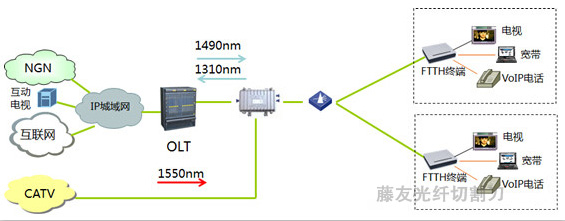
Three wavelengths of a fiber to the user's home: 1550nm optical transmitter wavelength to transmit TV programs, in order to ensure that the optical power received by the CATV light receiving module is within the normal range, the 1550nm optical signal generally needs to be amplified, and then combined Wave processing; using EPON to perform 1490nm wavelength and uplink 1310nm wavelength for two-way data services and interactive video services such as IPTV. Through CWDM multiplexing, the three wavelengths of 1310, 1490, and 1550 are combined and processed to share the optical fiber and the optical splitting platform, thereby realizing the three wavelengths of FTTH to the home, which not only preserves the coverage of broadcasting and broadcasting, but also realizes the two-way network service of broadband data. And multimedia services such as IPTV. The CWDM overlay of RF and EPON is used to achieve the convergence of broadcast and data networks. The passive demultiplexing device and the optical receiving module are integrated in the ONU device of the user end. After the mixed data reaches the ONU, the first wave processing is performed, and the optical signal of the EPON data enters the output data signal of the PON optical module, and the optical signal of the CATV enters. The optical receiver module outputs a radio frequency television signal.
2.2, dual fiber three wave FTTH mode
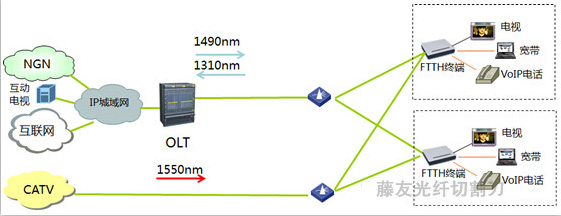
The CATV service is split by a split optical fiber and transmitted to the ONU through the optical splitter. After the CATV signal passes through the built-in photoelectric converter of the ONU, the CATV signal is transmitted to the CATV television through the RF interface.
Technical features: ONU embeds CATV photoelectric converter; uses dual fiber to transmit data and CATV signal separately; uses 1310/1550nm to transmit CATV signal. The two-way three-wave mode can completely isolate the baseband IP data and the modulated TV signal. Because the optical network structure of the EPON is similar to that of the traditional HFC optical network, it can achieve the same core of the same fiber routing. Moreover, there is no special requirement for the light source signal for modulating the radio frequency signal, and 1310 nm or 1550 nm can be used. When there is a spare fiber core for the laying of the optical cable for the broadcasting and television, the double-fiber three-wave method can be used for the FTTH coverage.
3. FTTH optical distribution network deployment
ODN is a FTTH fiber optic cable network based on PON equipment. Its role is to provide an optical transmission channel between the OLT and the ONU. From the functional point of view, the ODN can be divided into four parts: the feeder line subsystem, the wiring system, the subscriber line cable subsystem and the fiber terminal subsystem.
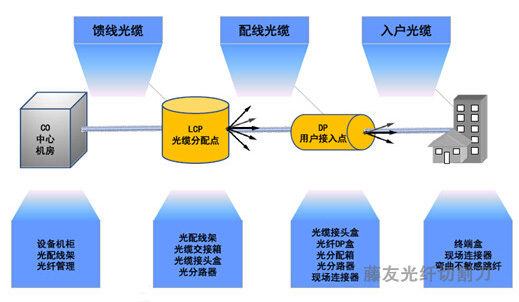
Due to the different economic development conditions, environmental natural conditions, population density, and original optical cable network resources, the construction mode suitable for local resources should be adopted in different regions.
Here are three common ODN network architectures:
1, centralized grading
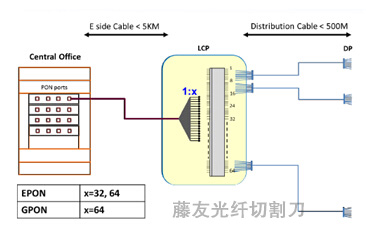
The optical splitter is centrally set in the LCP cable distribution point, the user management is concentrated, and the PON port utilization is high, but the construction cost of the distribution network is large, the fiber usage is large, the fiber construction cost is high, and it is suitable for small scale, and PON The application of the initial stage of FTTH construction with high port cost also requires controlling the scale of passive optical nodes to reduce the difficulty of fiber management.
2, two-stage splitting

The secondary splitters are set at the LCP and DP points respectively. The fiber usage is small and the engineering speed is fast. It can realize a wide range of fiber user coverage with a small cost and the fastest speed. It is suitable for suburban and rural areas with less dense population density or The old city carries out fiber coverage of FTTH users, but the link loss is higher than that of the first-order split, and the optical splitter device costs are high under full coverage.
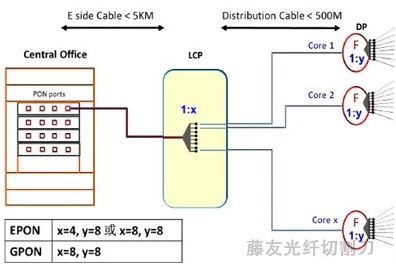
3, scattered first-level splitting
The optical splitter sinks to the DP point, and the amount of fiber used is small. It can realize a wide range of fiber coverage with the least cost and the fastest speed. It is suitable for FTTH fiber coverage in dense urban areas with high density and high-rise, but more In the old town, which is mainly built on the floor, a smaller splitter box can be set up between the DP and the user, which can also be called a secondary DP.
Part of the picture content comes from the Internet
If there is infringement, please contact the author to delete
Links
Magic Lamp